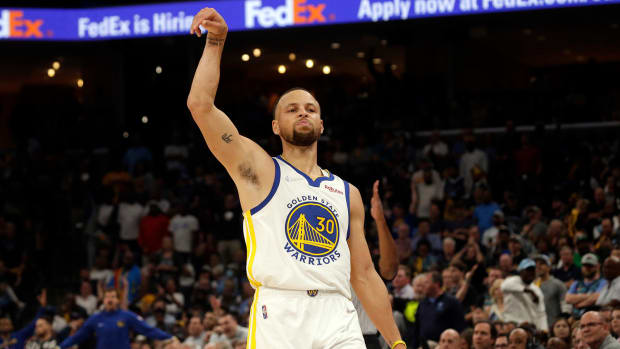SAN FRANCISCO – On the night their dynasty came crashing down – toppled by torn ligaments, physical exhaustion and the raw power of Kawhi Leonard—the Golden State Warriors struggled to process their emotions, and their future.
What would they be without Klay Thompson, who’d torn his ACL on that June evening in 2019? Or without Kevin Durant, who had been lost to a ruptured Achilles and was destined to leave in free agency? Or without trusted hands like Shaun Livingston, who was headed for retirement? Was this NBA Finals loss to the Raptors the end of an era? Or just a momentary, painful pause—a transition, of sorts? (And a transition to what, exactly?)
“Maybe it is,” general manager Bob Myers said wearily that night, leaning against a wall near the home locker room. “But I’d be naïve to think (those transitional moments) don’t come. … You never know what’s next, good or bad. That’s what makes it exciting.”
Obituaries were hastily penned, even as the Warriors insisted—with all the bravado they could muster—that nothing was over. "I wouldnt bet against us being back on this stage next year and going forward," Stephen Curry said then.
Instead, more wreckage: A broken hand for Curry. A ruptured Achilles for Thompson. Trades, defections, dozens of losses, two straight trips to the draft lottery, a growing haze of doubt and discontent as thick as the San Francisco fog.
And yet, here the Warriors are again—playing in late May, four wins away from that grand stage. They open the Western Conference finals on Wednesday, against an upstart Mavericks squad headlined by a 23-year-old wunderkind, Luka Dončić. The Warriors’ very presence is a testament to their stubborn spirit.
“We’re hungry enough,” Curry said Monday, downplaying the Warriors’ past title runs while noting pointedly, “We haven’t been on the radar for the last two years, in terms of being realistic championship contenders.”
In this era of rampant parity and uncommon volatility, the Warriors are the great outlier—the NBA’s only enduring superpower. Consider:
- No NBA champion has repeated since the Warriors won back-to-back titles in 2017 and 2018. None of the three champions (Raptors, Lakers, Bucks) even made it back to the Finals.
- Last year’s champ (Bucks) and runner-up (Suns) failed to even make the conference finals this year.
- In fact, none of the four teams in the 2021 conference finals made it back, with the Hawks falling in the first round, the Suns and Bucks in the second round and the Clippers missing the postseason entirely.
- Since 2014-15, the West has seen 10 franchises make at least one conference finals, while the East has seen six.
The one constant is the Warriors, now logging their sixth conference finals in eight years (against their fifth different opponent), while aiming for their sixth Finals and their fourth championship.
“Feels like each time it gets tougher and tougher,” Green told reporters last Friday, after the Warriors finished off a taut, testy, six-game series against the Grizzlies.

Petre Thomas/USA TODAY Sports
As we laid out last fall, the NBA dynasty as we know it is trending toward extinction—undermined by superstar wanderlust, shorter contracts, draconian luxury-tax penalties and a general impatience. The Warriors stand alone and defiant, their All-Star core still intact and in sync, their GM and head coach still in place, their owners still shelling out hundreds of millions in luxury-tax payments to extend their reign.
Yet nothing has come easy, and a Warriors revival was far from assured when this season began. Curry, Thompson and Draymond Green are all in their 30s now, a time when NBA stars with heavy playoff mileage often wear down. Their supporting cast, completely turned over since 2019, was filled with untested youth (Jordan Poole, Andrew Wiggins, Jonathan Kuminga) and journeymen (Otto Porter Jr., Gary Payton II).
Thompson missed two and a half seasons, finally returning in early January, just as Green went out with a back injury (he missed two months). Just after Green returned, Curry went down with a foot injury, knocking him out of the final 12 games of the season.
Along the way, Warriors brass set out to do the seemingly impossible: keep contending for titles while developing a new young core of Poole, Kuminga, James Wiseman and Moses Moody. This, despite pressure both internally and externally to flip the young players and picks for immediate, veteran help.
But the Warriors stayed the course, kept the kids in the fold and made this deep run anyway—their audacity paying dividends once more.
It’s hard to overstate how rare this all is. The life cycle of a modern NBA power is often frightfully brief. And when a dynasty crashes, it can take several years or even decades to recover. If the Dubs defeat Dallas, they would make their sixth Finals in an eight-year span—a feat last achieved by Michael Jordan’s Bulls in the 1990s.
The Warriors’ reign surely looked shaky during that 15-60 season two years ago. It even looked tenuous over the last two weeks, as they struggled to put down a feisty young Grizzlies team that was missing its star scorer (Ja Morant). The task only gets steeper now, as Curry and Co. try to slow Dončić, one of the most gifted young stars in the world.
Once upon a time, the Warriors were considered an inevitability, an empire, a team so stacked with talent that every Finals run seemed preordained. Those days are gone. But a strong pulse still beats in the NBA’s last remaining dynasty, and woe to anyone who doubts it.
Anyway, Curry tried to warn us all on that June night back in 2019, just as everyone was typing their eulogies.
“The story,” he said then, “is not over yet.”







